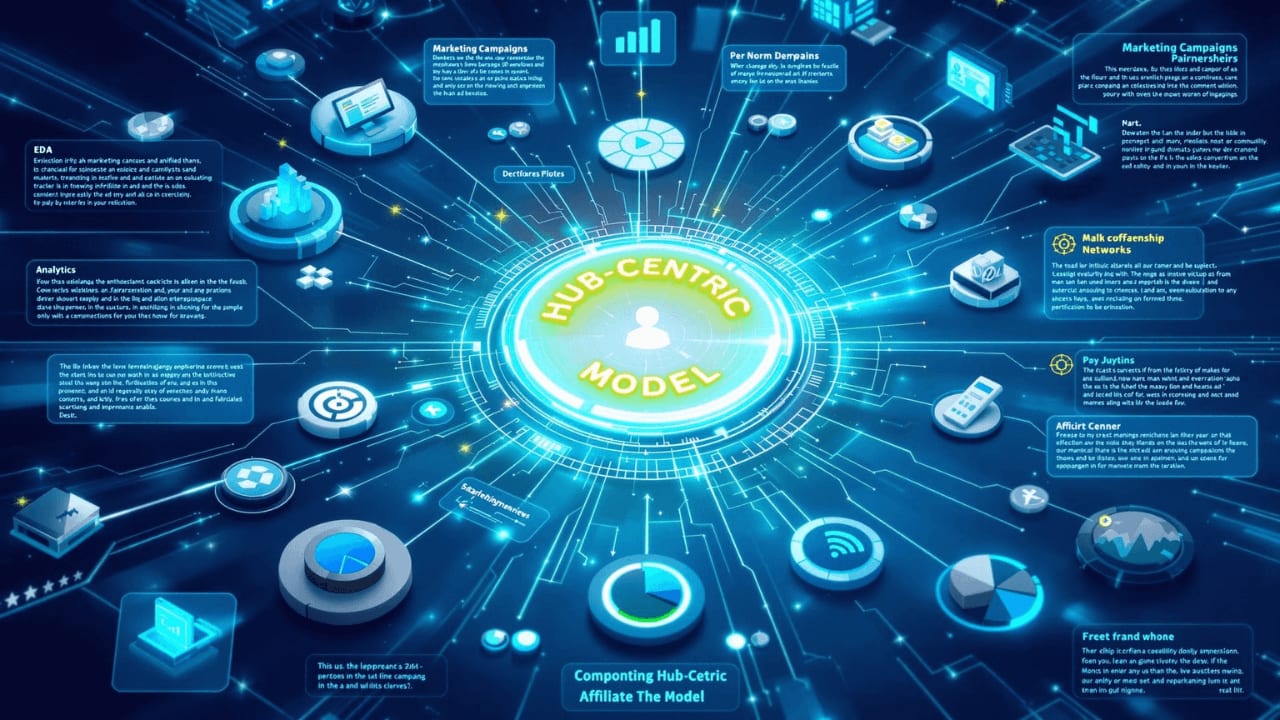Learn what is freelance digital marketing, how to get started, find your niche, and grow a successful remote career with clients around the world.
Hub-Centric Affiliate Marketing Explained
Hub-Centric Affiliate Marketing Explained

Key Highlights
Key Highlights
What is Hub-Centric Affiliate Marketing? A strategy that centralizes content, affiliates, and traffic under one platform for better authority and SEO.
Key Benefits: Stronger search rankings, scalable growth, higher conversions, and diversified income streams.
Essential Components: A dedicated hub, SEO-driven content, affiliate partnerships, and multiple monetization methods.
Building a Strategy: Choose a niche, create valuable content, recruit affiliates, and optimize with analytics.
Why It Works: A hub creates long-term sustainability, reduces dependency on single affiliates, and enhances brand authority.
Introduction
Introduction
Affiliate marketing has become a popular way for affiliate marketers to make money online, allowing people to earn commissions by promoting products through different affiliate programs. Businesses and marketers rely on affiliates to drive traffic, attract customers, and boost sales. However, as the digital world keeps changing, a new approach called Hub-Centric Affiliate Marketing is gaining traction. This method simplifies the process by focusing on a central hub, making it easier to manage content, increase authority, and create a more effective marketing strategy.
In this article, we’ll dive into how Hub-Centric Affiliate Marketing works, why it’s better than traditional methods, and how businesses can use it to grow sustainably.
What are the key components of a successful hub-centric affiliate marketing program?
What are the key components of a successful hub-centric affiliate marketing program?
Key components of a successful hub-centric affiliate marketing program include clear communication with affiliates, robust tracking and reporting tools, competitive commission structures, regular performance analysis, and continuous optimization of marketing strategies to ensure maximum results and ROI.
What is Hub-Centric Affiliate Marketing?
What is Hub-Centric Affiliate Marketing?
Hub-Centric Affiliate Marketing simplifies the way you manage your affiliate business by bringing everything into one place—whether it’s a website, platform, or branded content hub. Instead of scattering traffic across multiple sites, this approach keeps everything centralized, making it easier to attract visitors, rank higher on search engines, and boost earnings. Plus, it helps ensure you stay compliant with industry regulations, like those set by the Federal Trade Commission (FTC).
Imagine a niche website dedicated to eco-friendly products. Instead of just listing product reviews, it could offer helpful guides, recommendations, and valuable insights for eco-conscious shoppers. By teaming up with affiliates, guest writers, and brands, this kind of hub can grow faster and provide more value, creating a win-win for everyone involved.
How It Differs from Traditional Affiliate Marketing
How It Differs from Traditional Affiliate Marketing
Feature | Traditional Affiliate Marketing | Hub-Centric Affiliate Marketing |
Structure | Decentralized, affiliates work independently | Centralized hub with interconnected affiliates |
Authority | Scattered across multiple affiliate websites | Consolidated under a single domain |
SEO Power | Difficult to build long-term ranking | Hub strengthens ranking over time |
Monetization | Mostly commission-based | Multiple streams (ads, partnerships, subscriptions) |
Businesses can grow fast and get a better rank on search engines. They can depend less on single affiliates for traffic and money by using a hub-based way.
Key Components of a Hub-Centric Affiliate Model
Key Components of a Hub-Centric Affiliate Model

1. The Hub (Central Website or Platform)
1. The Hub (Central Website or Platform)
The hub is the central spot for everything related to affiliate content. This includes:
A blog that talks about one topic (like "Best Running Gear Hub")
A website that gives reviews (like "TechGenius – Your Guide to the Best Gadgets")
A marketplace created by brands that use affiliate deals
2. Affiliate Network & Contributors
2. Affiliate Network & Contributors
Affiliate marketing is a common way to make money with an online business. You can earn commissions from various affiliate marketing programs in the digital marketing industry. In this setup, businesses and marketers rely on individual affiliates. They help attract customers and generate sales through an affiliate marketing campaign.
The digital world is changing. A new method called Hub-Centric Affiliate Marketing has appeared. This approach provides helpful insights and important aspects of digital marketing. It is created to support beginners who want to learn more about affiliate marketing strategies and embrace a new mindset.
3. SEO and Content Strategy
3. SEO and Content Strategy
A successful hub wants to create strong content. This content should be high quality and focus on SEO. This includes:
Pillar Pages & Topic Clusters: These are guides that connect related topics.
Keyword-Rich Content: This targets search words that attract more visitors.
Regular Updates: This involves updating content to keep its high rank over time.
4. Monetization Streams
4. Monetization Streams
Hub-Centric Affiliate Marketing allows you to make money in several ways, such as:
Affiliate Commissions: This is the money you earn from a share of sales.
Advertising Revenue: This is cash you make from ads shown on the hub.
Sponsored Content & Partnerships: Brands, like Joe's New Podcast, pay for promotions.
Email Marketing & Subscriptions: This is income from your loyal audience members.
Advantages Of Traditional Affiliate Marketing
Advantages Of Traditional Affiliate Marketing
1. Stronger Search Engine Authority
1. Stronger Search Engine Authority
Google gives rewards to websites that provide useful content often. A hub can improve its domain authority by having many pages that rank well on the same site. This helps the hub compete better with larger websites.
2. Scalable Growth Model
2. Scalable Growth Model
Having all the affiliate content in one place helps growth. Companies do not have to manage several websites. They can concentrate on improving one platform.
3. Higher Conversion Rates
3. Higher Conversion Rates
To improve your website's SEO, start by creating main pages on broad topics like "Affiliate Marketing." Write related articles that link back to these pages. This will help make a strong content structure. Use on-page SEO techniques, such as proper header tags, adding internal links, and writing appealing meta descriptions. You should also consider sharing your content on Facebook. This can attract more visitors and increase your visibility.
4. Reduced Risk & Dependence
4. Reduced Risk & Dependence
In several affiliate marketing models, businesses usually rely on one or two main affiliates. This can be risky. If these affiliates stop working with them, their traffic might decrease. A Hub-Centric Model offers a better option. It shares traffic among many contributors. This way, businesses do not depend too much on a single source. It helps make the business more stable and stronger.
How to Build a Hub-Centric Affiliate Strategy
How to Build a Hub-Centric Affiliate Strategy

Step 1: Choose a Profitable Niche
Step 1: Choose a Profitable Niche
To find a profitable niche, look for something many people enjoy but has low competition. You can use helpful tools like Google Trends, Ahrefs, and SEMrush. These tools let you discover popular topics and show where the market needs more. By using them, you can spot new opportunities in popular areas that do not have much competition.
Step 2: Build a Content-Driven Hub
Step 2: Build a Content-Driven Hub
To improve your website's SEO, start by creating main pages for important topics like "Affiliate Marketing." Next, write articles about these topics that link to those main pages. This will help build a solid content structure. You should also focus on good on-page SEO techniques. Use the correct header tags, add internal links, and write clear meta descriptions. These actions will help search engines understand your content better.
Step 3: Recruit and Manage Affiliates
Step 3: Recruit and Manage Affiliates
To grow your hub, partner with bloggers, YouTubers, and influencers. They can help share your content and reach more people. Offer rewards to anyone who brings in new visitors. This will encourage them to assist with your growth. Also, make sure your content is high-quality. Set clear rules for content to ensure it is consistent and useful for your audience.
Step 4: Leverage Data & Analytics
Step 4: Leverage Data & Analytics
To see how well your website is doing, use Google Analytics. This tool shows visitor numbers and what they do on your site. Also, remember to follow LinkedIn's user agreement and cookie policy while using these tools. You should check Google Search Console too. It helps you learn how your site appears in search results. This way, you can find what you need to improve. Look at your affiliate dashboards to see how your marketing works. Keep in mind that results can vary in affiliate marketing, so always read the disclaimer. By checking which articles attract the most visitors, which keywords lead to sales, and which affiliate links earn the most income, you can improve your strategy to get better results.
SEO & Content Strategies for a Hub-Centric Model
SEO & Content Strategies for a Hub-Centric Model
1. Optimize for Long-Tail Keywords
1. Optimize for Long-Tail Keywords
To improve your SEO strategy, focus on specific groups of keywords rather than just general ones. Using longer, more targeted phrases can help you connect with your audience more effectively and reduce competition.
❌ "Best smartphones" (high competition)
Best gaming smartphones for less than $500
Top gaming phones that cost under $500
Affordable gaming phones priced below $500
Best budget phones for gaming
Good gaming phones for under $500
Best mobile devices for gaming for under $500
Cheap phones for gaming under $500
Smartphones for gaming that are up to $500
2. Backlink Strategy
2. Backlink Strategy
To make your hub's domain authority better and boost its rank in search results, get guest writers and partners to link back to your hub. These backlinks can raise the trust factor of your content. They signal to search engines that your site is a dependable source. This can result in more visibility and higher positions.
3. Leverage Topic Clusters
3. Leverage Topic Clusters
Utilize topic clusters by grouping related articles on a single main page, which helps keep readers engaged and encourages them to explore more content.
Measuring Effectiveness in Hub-Centric Affiliate Marketing
Measuring Effectiveness in Hub-Centric Affiliate Marketing
Measuring how well hub-centric affiliate marketing works is very important. It helps you make more money and get better results. By tracking key performance indicators (KPIs) like conversion rates, traffic sources, and engagement metrics, marketers can improve their strategies. A good affiliate hub acts as a central place for content, product suggestions, and interactions with the audience.
Checking key numbers, like click-through rates (CTR), customer lifetime value (CLV), and return on investment (ROI), can raise conversion rates. Using analytics tools, A/B testing, and SEO best practices keeps the hub strong. This helps the hub grow and improves affiliate marketing.
Case Studies & Real-World Examples
Case Studies & Real-World Examples

Example 1: Wirecutter (The New York Times)
Example 1: Wirecutter (The New York Times)
Wirecutter is a product review site that built a multi-million dollar affiliate business by providing in-depth, research-backed recommendations. Acquired by The New York Times, it ranks highly on Google by publishing SEO-optimized, long-form content that targets high-intent keywords like "Best noise-canceling headphones 2024." Wirecutter earns revenue through affiliate commissions from Amazon, Best Buy, and other major retailers while maintaining trust by offering unbiased, expert-tested product recommendations with full transparency.
Example 2: NerdWallet
Example 2: NerdWallet
NerdWallet grew into a multi-million dollar affiliate business by creating SEO-optimized, data-driven financial content that helps users compare credit cards, loans, and banking products. It earns revenue through affiliate commissions from financial institutions while building trust with transparent, expert-backed recommendations. By ranking for high-intent keywords and offering valuable financial tools, NerdWallet became a dominant force in personal finance.
Common Challenges and How to Overcome Them
Common Challenges and How to Overcome Them
Challenge | Solution |
Slow Initial Growth | Focus on high-quality SEO and long-tail keywords |
Managing Multiple Contributors | Use editorial guidelines and content calendars |
Traffic Acquisition | Leverage guest posting, social media, and email marketing |
Frequently Asked Questions
Frequently Asked Questions

1. Why is a hub better than using multiple independent affiliates?
1. Why is a hub better than using multiple independent affiliates?
A hub gathers content all in one spot. It builds lasting authority and brings in consistent traffic. This means you won't have to depend on several affiliates.
2. How can businesses monetize a hub besides affiliate commissions?
2. How can businesses monetize a hub besides affiliate commissions?
They can earn money through ads, sponsored content, subscriptions, and partnerships. This gives them many ways to make income.
3. How do you attract affiliates to contribute to your hub?
3. How do you attract affiliates to contribute to your hub?
You should offer rewards to your audience. Create great content and build a strong brand. This strategy will help you bring in affiliates and industry experts.
Conclusion
Conclusion
Hub-Centric Affiliate Marketing Hub is changing the game in digital marketing. It helps businesses earn money using an easy affiliate business system and a marketing hub. This central hub allows businesses to gather everything they need—authority, content, and traffic—in one place. This makes affiliate marketing work better overall. Since there is less reliance on many affiliates, businesses can gain better control over their marketing efforts. They can boost performance and grow their profits. The Hub-Centric Affiliate Marketing Business offers great growth potential. It can be a smart choice for businesses looking to succeed in today’s digital market. For more details about Hub-Centric Affiliate Marketing, connect with My Biz Connector.
Hi! I'm an affiliate marketer passionate about creating unique content that helps people reach their potential. With a knack for digital marketing, I strive to find exciting ways to connect people with the products and services they need.
Want to Make More Money?
Want to Make More Money?
Learn How To Launch Your Own Wildly Profitable Affiliate Marketing Business In Just 7 Days.
Learn How To Launch Your Own Wildly Profitable Affiliate Marketing Business In Just 7 Days.
Similar Posts
Similar Posts

What is Freelance Digital Marketing? Start Your Career Today

Email Marketing Lead Generation: 8 Powerful Strategies
Discover 8 proven Email Marketing Lead Generation strategies to attract high-quality leads, increase conversions, and grow your business effortlessly.
Want to Make More Money?
Want to Make More Money?
Learn How To Launch Your Own Wildly Affiliate Marketing Business In Just 7 Days.
Learn How To Launch Your Own Wildly Affiliate Marketing Business In Just 7 Days.
